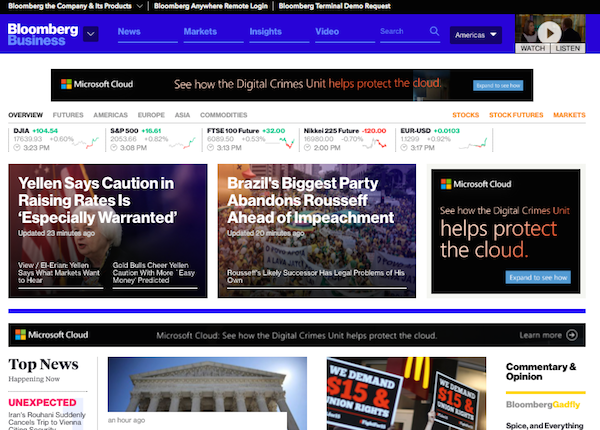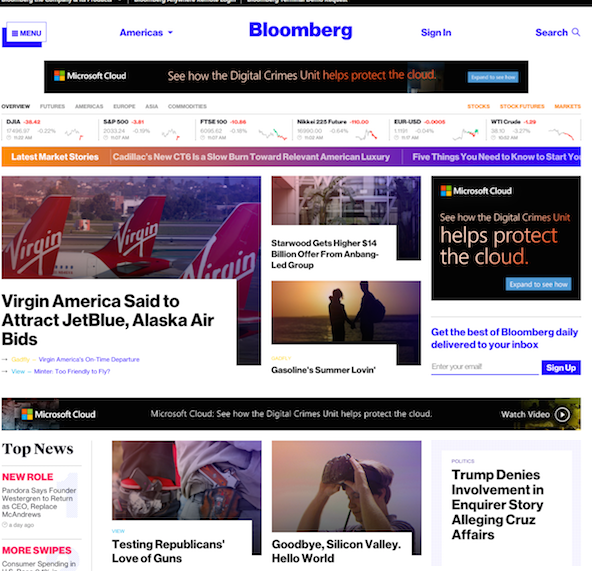Bloomberg is dropping the Business from Bloomberg Business to leave just Bloomberg

Going forward, Bloomberg Business will be simply “Bloomberg.” The consumer financial news site will just go by the name of its namesake founder as part of a homepage redesign that went live Tuesday afternoon.
Bloomberg the parent company has used its media arm to reach a bigger audience beyond the core subscribers to its $21,000-a-year financial news and data service. The leadership there now says the media arm’s site has grown in traffic and digital ad revenue to the point that the very name “Bloomberg” is synonymous with “business.” Traffic to the site grew 38 percent year over year to 27.3 million unique visitors in February, per comScore U.S., and digital revenue grew 18 percent year to date versus the year-ago period, according to the company.
At the same time, the site itself has become more than just a business publication, having launched multi-platform verticals for opinion and politics. A full-fledged tech vertical is also in the works for later this year.
“Our strategy is really built on this portfolio of sub-brands that have become large and successful in their own right, and it was redundant to have ‘business,’” explained Justin Smith, global CEO of Bloomberg Media.
Last year, Bloomberg Media launched a marketing campaign to expand its audience to a global business reader, and with today’s change, the company is saying that effort paid off. “As our ad campaign stated, Business is Bloomberg, and we are fully embracing this position going forward,” Smith wrote in a memo to staff.
There’s a practical reason for the change, too. The new name will align with the url, which has always been “Bloomberg.com,” with Bloomberg’s Twitter handles doing the work for its verticals (@business, @technology, @markets, @bpolitics @luxury).
It’s hard not to see the founder’s touch in the changes. Mike Bloomberg returned to the company in 2014 after an absence, during which he was New York’s mayor, and is said to be closely involved in every aspect of the company, including the redesign.
The former mayor’s return stirred speculation about the future of the media arm; publishing is a tough business, and Bloomberg already has its highly lucrative subscription-based terminal operation. There were reports that Mike Bloomberg didn’t like the splashy look of the last redesign, by now-former employee Josh Topolsky, and questioned the need for having the site at all.
The new site retains the bright colors of the last redesign (both were done with help from Code and Theory), but the colors are now used much more sparingly, and there’s much more white space now. The changes affect the mobile and desktop versions; here are screenshots of the old and new desktop version:


Editorially, the site’s mandate hasn’t changed, though, said Scott Havens, who was brought in last November as global head of digital for Bloomberg Media. “We are laser-like focused on the global business executive. Our strategy will reflect that,” he said.
Along with the name change, the new homepage gives more airplay to Bloomberg Business’s verticals, including weekly magazine Bloomberg Businessweek. In other notable changes, there will be more prominent placement of video and sponsored content — as the company tries to capitalize on two areas that hold potential for strong revenue growth.
More in Media

YouTube is under fire again, this time over child protection
Adalytics Research asks, ‘Are YouTube advertisers inadvertently harvesting data from millions of children?’

Media Briefing: Publishers pump up per-subscriber revenue amid ad revenue declines
Publishers’ Q2 earnings reveal digital advertising is still in a tight spot, but digital subscriptions are picking up steam.

Lessons for AI from the ad-tech era: ‘We’re living in a memory-less world’
Experts reflect how the failures of social media and online advertising can help the industry improve the next era of innovation.
Ad position: web_bfu